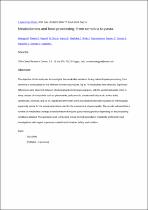JavaScript is disabled for your browser. Some features of this site may not work without it.
- ResearchSpace
- →
- Research Publications/Outputs
- →
- Journal Articles
- →
- View Item
| dc.contributor.author |
Beleggia, R

|
|
| dc.contributor.author |
Platani, C

|
|
| dc.contributor.author |
Papa, R

|
|
| dc.contributor.author |
Di Chio, A

|
|
| dc.contributor.author |
Barros, E

|
|
| dc.contributor.author |
Mashaba, C

|
|
| dc.contributor.author |
Wirth, J

|
|
| dc.contributor.author |
Fammartino, A

|
|
| dc.contributor.author |
Sautter, C

|
|
| dc.contributor.author |
Conner, S

|
|
| dc.contributor.author |
Rauscher, J

|
|
| dc.contributor.author |
Stewart, D

|
|
| dc.contributor.author |
Cattivelli, L

|
|
| dc.date.accessioned | 2011-11-09T14:47:51Z | |
| dc.date.available | 2011-11-09T14:47:51Z | |
| dc.date.issued | 2011-09 | |
| dc.identifier.citation | Beleggia, R, Platani, C, Papa, R et al. 2011. Metabolomics and food processing: From semolina to pasta. Journal of Agricultural and Food Chemistry, Vol 59(17), pp 9366-9377 | en_US |
| dc.identifier.issn | 0021-8561 | |
| dc.identifier.uri | http://www.ncbi.nlm.nih.gov/pubmed/21812406 | |
| dc.identifier.uri | http://hdl.handle.net/10204/5281 | |
| dc.description | Copyright: 2011 American Chemical Society. ABSTRACT ONLY | en_US |
| dc.description.abstract | The objective of this study was to investigate the metabolite variations during industrial pasta processing (from semolina to dried pasta) for five different commercial products. Up to 76 metabolites were detected. Significant differences were observed between wholemeal and refined pasta samples, with the wholemeal pasta richer in many classes of compounds such as phytosterols, policosanols, unsaturated fatty acids, amino acids, carotenoids, minerals, and so on. Significant differences were also observed between samples of refined pasta apparently similar for the actual parameters used for the assessment of pasta quality. The results indicated that a number of metabolites undergo a transformation during the pasta-making process depending on the processing conditions adopted. The approach used in this work shows the high potential of metabolite profiling for food investigations with regard to process-related transformation, safety, and nutrition. | en_US |
| dc.language.iso | en | en_US |
| dc.publisher | American Chemical Society | en_US |
| dc.relation.ispartofseries | Workflow request;7494 | |
| dc.subject | Metabolomics | en_US |
| dc.subject | Metabolic profiling | en_US |
| dc.subject | Nutrition quality | en_US |
| dc.subject | Pasta processing | en_US |
| dc.subject | Food processing | en_US |
| dc.subject | Semolina | en_US |
| dc.subject | Agriculture | en_US |
| dc.subject | Food chemistry | en_US |
| dc.title | Metabolomics and food processing: From semolina to pasta | en_US |
| dc.type | Article | en_US |
| dc.identifier.apacitation | Beleggia, R., Platani, C., Papa, R., Di Chio, A., Barros, E., Mashaba, C., ... Cattivelli, L. (2011). Metabolomics and food processing: From semolina to pasta. http://hdl.handle.net/10204/5281 | en_ZA |
| dc.identifier.chicagocitation | Beleggia, R, C Platani, R Papa, A Di Chio, E Barros, C Mashaba, J Wirth, et al "Metabolomics and food processing: From semolina to pasta." (2011) http://hdl.handle.net/10204/5281 | en_ZA |
| dc.identifier.vancouvercitation | Beleggia R, Platani C, Papa R, Di Chio A, Barros E, Mashaba C, et al. Metabolomics and food processing: From semolina to pasta. 2011; http://hdl.handle.net/10204/5281. | en_ZA |
| dc.identifier.ris | TY - Article AU - Beleggia, R AU - Platani, C AU - Papa, R AU - Di Chio, A AU - Barros, E AU - Mashaba, C AU - Wirth, J AU - Fammartino, A AU - Sautter, C AU - Conner, S AU - Rauscher, J AU - Stewart, D AU - Cattivelli, L AB - The objective of this study was to investigate the metabolite variations during industrial pasta processing (from semolina to dried pasta) for five different commercial products. Up to 76 metabolites were detected. Significant differences were observed between wholemeal and refined pasta samples, with the wholemeal pasta richer in many classes of compounds such as phytosterols, policosanols, unsaturated fatty acids, amino acids, carotenoids, minerals, and so on. Significant differences were also observed between samples of refined pasta apparently similar for the actual parameters used for the assessment of pasta quality. The results indicated that a number of metabolites undergo a transformation during the pasta-making process depending on the processing conditions adopted. The approach used in this work shows the high potential of metabolite profiling for food investigations with regard to process-related transformation, safety, and nutrition. DA - 2011-09 DB - ResearchSpace DP - CSIR KW - Metabolomics KW - Metabolic profiling KW - Nutrition quality KW - Pasta processing KW - Food processing KW - Semolina KW - Agriculture KW - Food chemistry LK - https://researchspace.csir.co.za PY - 2011 SM - 0021-8561 T1 - Metabolomics and food processing: From semolina to pasta TI - Metabolomics and food processing: From semolina to pasta UR - http://hdl.handle.net/10204/5281 ER - | en_ZA |






